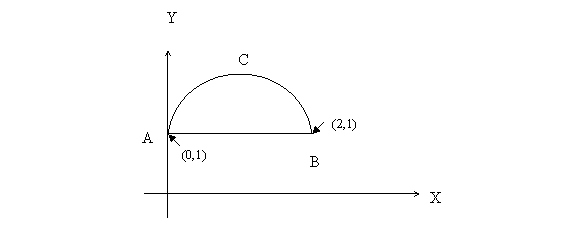Example: Take
the force field given by  and
consider a particle moving from A to be along the semicircular
path ACB (see figure below). Calculate the difference
in its kinetic energy at B and at A. and
consider a particle moving from A to be along the semicircular
path ACB (see figure below). Calculate the difference
in its kinetic energy at B and at A.

To calculate the change in the kinetic energy of the particle
as it moves from A to B, we should calculate the work
done by the force in when the particle travels along
the semicircle. For this we should calculate

with y and dy calculated from the
equation of the circle  .
You should try it and see for yourself that the integrals
become really lengthy. On the other hand, if the force
is conservative, we can calculate the work done in particle
moving along the diameter. The latter calculation is
much easier. Let us therefore first calculate the curl
of the force. It is .
You should try it and see for yourself that the integrals
become really lengthy. On the other hand, if the force
is conservative, we can calculate the work done in particle
moving along the diameter. The latter calculation is
much easier. Let us therefore first calculate the curl
of the force. It is

Thus the work done between any two points is path-independent.
We therefore calculate the work along the diameter AB.
It is

Since the work done is independent of the path, it is
going to be the same for the semicircular path ACB also.
After defining the potential energy and getting the principle
of conservation energy, we now look a little more at
the relationship between the potential energy and the
force it gives rise to. As a consequence we also discuss
what can we learn about the motion of a particle by looking
at its potential energy curve. |